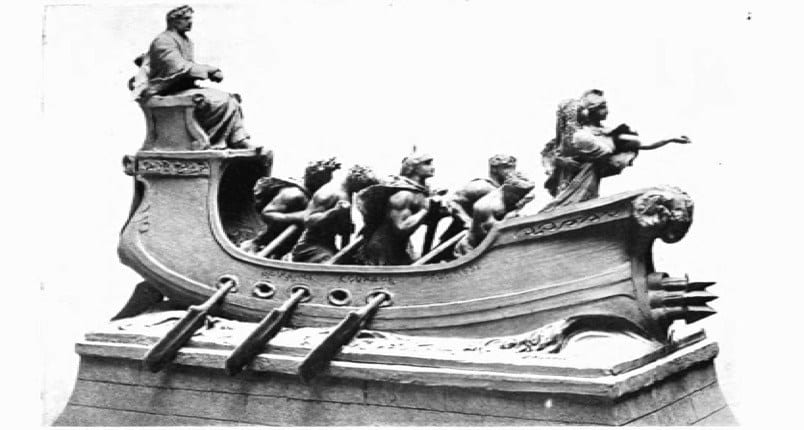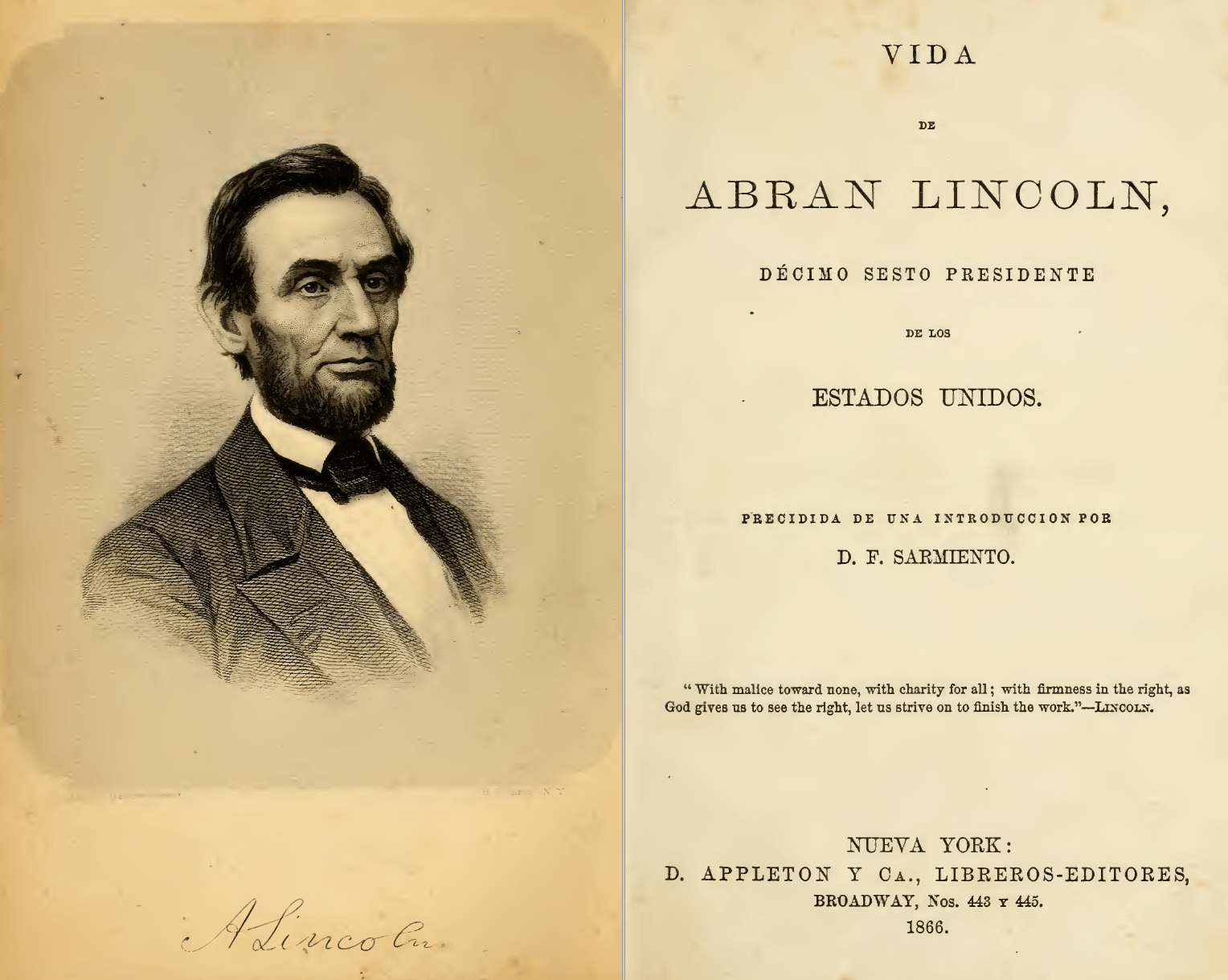By Editor Derek Kane O’Leary

Bela Pratt, model of proposed monument of Domingo Faustino Sarmiento (1916), Boston Archives and Records Management, Collection 0245.001.
American sculptor Bela Pratt imagined the above statue in 1916, but it was never built. In 1913, the Argentine congress had allotted $50,000 for a monument to their former President, renowned educator and man of letters Domingo Faustino Sarmiento (1811-1888; presidency, 1868-1874) to be placed in Boston, Massachusetts. It was intended to celebrate his long-held affinity with the city and some of its famed residents. World war intervened, Pratt passed away, and sixty years elapsed before this tribute to Sarmiento arose on Boston’s Commonwealth Avenue, bearing a quite different aesthetic and story. Dedicating that statue in 1973 before a crowd of locals and the Argentine diplomatic community, Mayor Kevin White reflected, “Sarmiento’s long journey back to the states has symbolic meaning; it helps to underscore both the historical importance of his pioneering role in education…and the yet unfulfilled challenge of achieving global peace and understanding through cultural exchange.” The statue now stands as the penultimate figure in the monuments marking the axis of Commonwealth Avenue. Sternly stepping forward into distinction from the rough bronze, he seems to brace himself against the world. He recalls a cloaked, much aged, and more somber kouros.

Statue of Domingo Faustino Sarmiento, erected in 1973, Boston, Massachusetts.
White’s oration muffled much of Sarmiento’s life and his relationship with the United States, and the monument chiseled away the far more pointed symbolism of the 1916 model. The dedication reduced Sarmiento to an agent of modern education cast in the American mold, and implied that his subordinate and aspiring stance toward the U.S. should be a model for the world to follow. Depicting Sarmiento as a synecdoche for Argentina, and Boston as one for the U.S, the local rhetoric certainly refracted through the global prism of the Cold War. It does illustrate the extent to which monuments can become disembodied from their historical subject and context. But this is not to say that either dedication or statue was wrong about Sarmiento. Indeed, White’s depiction preserves in essential ways how a lot Bostonians would have understood the Argentine during his presidency a century ago, and the forward motion of the solitary bronze captures some of the meaning that many nineteenth-century New Englanders would have perceived in Sarmiento’s life. However, if we keep the 1916 model in mind instead, it can in fact bring us somewhat closer to Sarmiento’s historic role within the Western Hemisphere.

Sarmiento quickly assembled and published in 1866 a commemoration of Lincoln, which he distributed to U.S. acquaintances.
In the post-Civil War U.S., Sarmiento fastened in the minds of elite New Englanders as an avatar of their values on the Argentine frontier. In exile during the military dictatorship of Juan Manuel de Rosa (1835-1852), Sarmiento first encountered Horace and Mary Mann in West Newton, Massachusetts in 1848, a crucial coda to a larger Atlantic tour of educational systems Europe. Enamored of their pedagogy, Sarmiento upon his return south would expand vastly on his earlier efforts to reform and extend education in South America. As ambassador to the U.S. from 1866 until his election, he increasingly appeared to his U.S. interlocutors as a South American Horace Mann. From the vantage point of the Charles River, it was surely validating to envision Sarmiento dispensing copies of his favorite book, Benjamin Franklin’s Autobiography, to students in the myriad new schoolhouses of the Argentine frontier. Mary (able in both Spanish and French, which enabled her to translate and communicate with Sarmiento) curated his image before the American public. She translated his classic work Facundo (1845) in 1868, which she scaffolded with a sweeping history of Argentina and glowing biography of its author. This served to amplify his prestige among the New England intelligentsia—which he thought beneficial to his political aspirations in Argentina; meanwhile, for her it promised to perpetuate the educational mission of her departed husband. (Their correspondence sprawled into the 1880s, comprising hundreds of letters.)
But Sarmiento called for a far more robust version of hemispheric integration than this, and therein we can detect a more complex and troubling historical kinship between North and South. Seldom at his station in the dreary capital, Sarmiento as ambassador roved the Northeast, forging connections with leading industrialists, military specialists, educators, and scholars. In 1866, in a notable example, he addressed the local intellectual, industrial, and business elite assembled at the Rhode Island Historical Society. With their expertise and capital flowing southward, he proposed merging the cloven paths of the northern and southern continents into one progressive historical trajectory. U.S. military officers to build forts against indigenous attacks; railroad and canal builders to incorporate their lands; schoolteachers to civilize them and the hoped for mass infusion of Northern European immigrants, and historians to craft the story. The intellectual disparity he perceived between North and South especially troubled him. Indeed, he flatteringly lamented to his audience, to tell the tale of Argentina’s ongoing war with Paraguay, the historian would need to peruse the archives and libraries of Providence.
To argue for this inter-American future, he looked to the past, and this drew him deeper into the Rhode Island archive and U.S. historical narrative. Long after the independence of the lands that would become Argentina, he yearned still to expunge what he perceived as the debilitating legacy of Spanish colonial misrule. In the U.S. he perceived a society and government guided by undiluted Anglo-Saxon reason and republican virtue; at home he bemoaned the legacy of a Hispanic population-which he portrayed as Medieval- mixed with a native population-which he saw as oriental. In short, he articulated a broader version of the historical narrative of U.S. exceptionalism, generated in spaces like the Rhode Island Historical Society and its peer institutions.
Sarmiento spoke in the spirit of the American jeremiad, imagining the regeneration of South American civilization against barbarism—to use the lexicon of his famous Facundo. To an audience well-acquainted with the mammoth historical works of William Hickling Prescott on the Spanish conquest of America and John Lothrop Motley on the Dutch Republic, he performed a historiographical flourish. Snidely, he queried which century and civilization Prescott hailed from, given the renowned historian’s light-handed treatment of Hernán Cortés’s depredations. But enthusiastically turning to Motley’s account of the Dutch revolt against Spanish rule, Sarmiento depicted the subsequent history of the new world as two great oceanic arcs emerging from that Low Countries battleground: the one by Pilgrims exiled to North America via Holland, bearing liberal principles of government; the second southward, borne by Spanish captains, who in the Spanish-Dutch conflict had “learned to harden themselves to crime and to the violation of divine laws.” Disregarding the far more complex ethnic landscape of New England and echoing a familiar version of the Black Legend, this vision of a bifurcated, almost Manichean hemispheric history would have resonated with the crowd. For both Sarmiento and his northern audience, the call for a North American model for the southern continent would have rung as a pleasing analogy to post-Civil War federal reconstruction of the South.
In promoting a collaborative future and renouncing a riven past, however, he then appealed to a deeper, pre-historic, and ostensibly non-European layer binding together the hemisphere, and which he imagined as inspiration for a shared historic purpose.
“Beyond the frontiers and the present, are the monuments of a civilization which has had its dark age but not its renaissance. America has her petrified cities, the abode of a great people who flourished in them, pyramids which rival those of Egypt, temples and palaces which now fertilized the trunks of trees centuries old…when these monuments, which begin with the mound and end with enormous masses of hewn stone, sculptured with a thousand hieroglyphics, have been studied, classified and compared, the history of both Americas will begin upon the same page…”
Here, Sarmiento has pealed back the layers of the archive, moving from contemporary geopolitics in South America, to trans-Atlantic colonization, to indigenous American civilization. Argentina’s preeminent nineteenth-century man of letters had early and untiringly leveraged writing to enhance personal and national power. By asserting cultural continuity among a markedly diverse range of pre-contact earthen and stone structures, Sarmiento was not positing a new take on hemispheric history, but petitioning that Argentina be inscribed on equal terms within it.
In claiming this shared path, lamenting a later historical divergence, and proposing a common future, Sarmiento sought to conjoin the histories of North and South America. Toward this end, what he modeled on the U.S.—and New England in particular—was much more than the pedagogy for which he was and has been known. It was a program for the coercive acquisition and industrialized integration of vast expanses of territory, and the ideal of perpetuating the Anglo-Saxon legacy of Europe in the Americas against lesser elements. Within the creeping logic of scientific racism, he would by the 1880s see these divergent American paths as the outcome of racial segregation and Anglo-Saxon purity in the North, and the mingling of Spanish and indigenous bloodlines in the South. (This is clearest in his 1883 Conflictos y Armonias de las Razas en America, dedicated to Mary Mann.)
In the 1916 model, Sarmiento, wreathed in laurels and Roman garb, sits atop the quarterdeck of his ship of state. Along the vessel’s side is etched “Education Courage Progress.” Charismatic rowers urge the vessel forward. Upon its prow, a martial and masculine version of Columbia holds Argentina in his arm, reaching out to that future with the other. For good measure, the brig is equipped with a spiked battering ram. The rhetorical construction of Sarmiento in the postwar U.S. press, among the contemporary New England republic of letters, and on Commonwealth Avenue today have disentangled the extraordinary educational impact of Sarmiento’s civilization project from the violence, coercion, and racial theory with which it was bound up. What we read in the inscription and form of Sarmiento’s statue today is a ripple of a much more complex reality.



1 Pingback